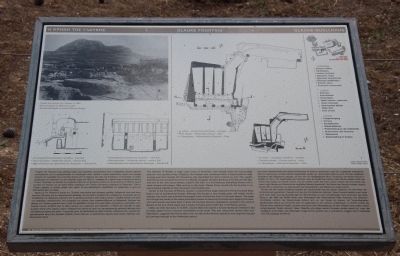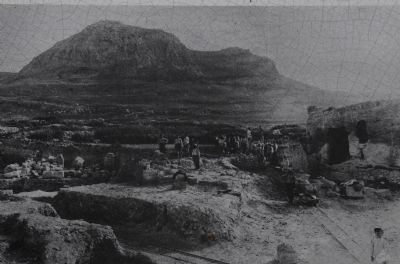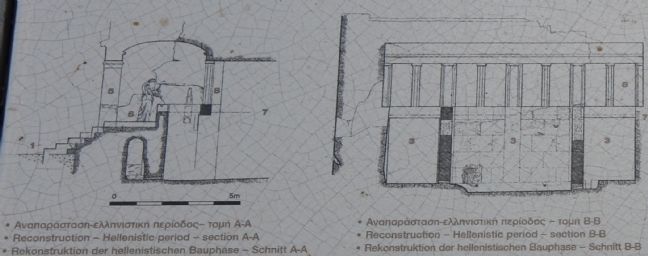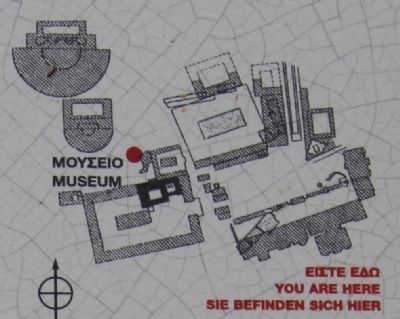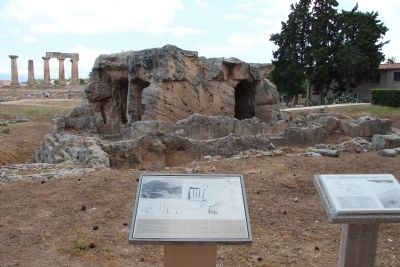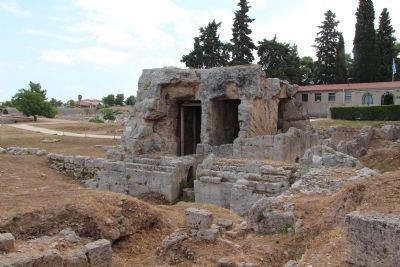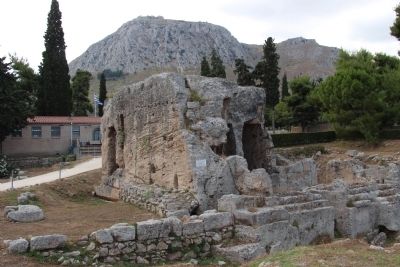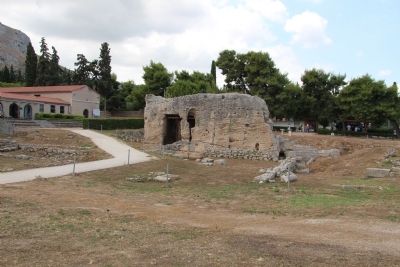Archea Korinthos in Korinthos, Peloponnese, Western Greece and the Ionian, Greece — Ελλάδα (Southeastern Europe, Balkan Peninsula)
Glauke Fountain
The fountain of Glauke, a large cubic mass of limestone, was formed when the surrounding bedrock was quarried away. Originally, the fountain was contained within a long limestone ridge running west from Temple Hill. Pausanias, who described his visit to Corinth ca. A.D. 150, reports that the fountain received its name from Glauke, daughter of Creon the King of Corinth and the second wife of the hero Jason. Medea, Jason's first wife, in a fit of jealousy presented Glauke with a cloak infused with poison. After putting on the cloak, Glauke threw herself into the fountain in an unsuccessful attempt to stop the poison from burning her.
Similar to the Fountain of Peirene, Glauke consists of four large reservoirs fronted by three draw basins and an architectural facade. Although this facade is now largely gone, still visible are the cuttings into which was inserted the parapet which formed the front of the draw basins. The deep cut through the center of the steps provided a means of removing the stone from digging the reservoirs and would have been filled in when the fountain became operational. Directly to the north of Glauke at the foot of the steps was a small courtyard paved with tiles in the Roman period.
Unlike all other fountains in Corinth, Glauke does not exploit a natural spring but instead is fed by water piped in from a source somewhere to the south. This fact, along with several other considerations, suggests that the fountain may not date to the Archaic period as was originally thought but perhaps belongs to the Hellenistic period.
Erected by LZ Ephoreia of Prehistoric & Classical Antiquities.
Topics. This historical marker is listed in this topic list: Notable Places.
Location. 37° 54.339′ N, 22° 52.679′ E. Marker is in Archea Korinthos, Peloponnese, Western Greece and the Ionian, in Korinthos. Marker can be reached from Enotiki Archeas Korinthou west of EO Korinthou Argous (Local Route 7), on the left when traveling north. This marker is located in the Archaeological Park of Ancient Corinth, and is one of the very first markers that visitors encounter upon first entering the archaeological park. Touch for map. Marker is in this post office area: Archea Korinthos, Peloponnese, Western Greece and the Ionian 200 07, Greece. Touch for directions.
Other nearby markers. At least 8 other markers are within walking distance of this marker. Ancient Corinth (here, next to this marker); Temple of Apollo (within shouting distance of this marker); Temple E (about 90 meters away, measured in a direct line); Road Network (about 90 meters away); Buildings at the West End of Roman Agora (about 120 meters away);
Archaeological Site of Ancient Corinth (about 150 meters away); The Rostra (Bema) of the Roman Forum (about 210 meters away); Lechaion Road (about 210 meters away). Touch for a list and map of all markers in Archea Korinthos.
More about this marker. With regards to the location of all of the markers in the Archaeological Park of Ancient Corinth, when going online and researching directional information, I could not locate any websites, or any online maps, that provided the names of the local streets, so it was difficult for me to provide accurate and detailed directional information. The street and crossroad that I have provided are the closest two "named" streets that I could locate on any of the maps that I used.
One online site provided the following directions for getting to the archaeological park: "By car: 90 minutes from Athens. The exit to Ancient Corinth, approaching from the north, is about 2 kilometers west of the Tripolis interchange. Warning: visitors familiar with the village before 1996 should take the Patras interchange not the new Tripolis highway to arrive from the other side of the village;
no exit was constructed and a U-turn cannot be made for ten kilometers."
Related markers. Click here for a list of markers that are related to this marker. To better understand the relationship, study each marker in the order shown.
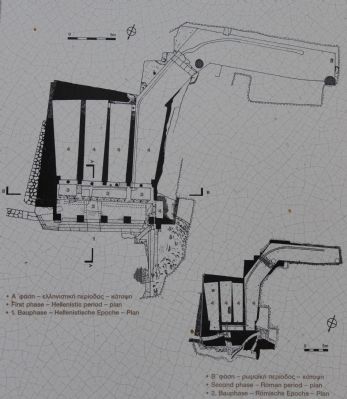
Photographed By Dale K. Benington, June 22, 2015
4. Glauke Fountain Marker
Close-up view, that is displayed on the marker, of an illustration, showing the Glauke and its four large reservoirs fronted by three draw basins, with the illustration on the left being from the Hellenistic period and the illustration on the right being from the Roman period.
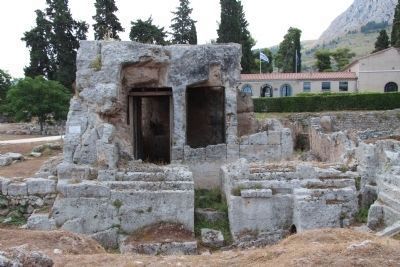
Photographed By Dale K. Benington, June 22, 2015
8. Glauke Fountain
A straight center frontal view of the Glauke Fountain, showing, "the deep cut through the center of the steps..." that was discussed in the text of the marker, with a view of the visitor center and site museum in the far right background.
Credits. This page was last revised on March 22, 2022. It was originally submitted on June 30, 2015, by Dale K. Benington of Toledo, Ohio. This page has been viewed 690 times since then and 117 times this year. Photos: 1, 2, 3, 4, 5, 6, 7, 8, 9, 10. submitted on June 30, 2015, by Dale K. Benington of Toledo, Ohio.
